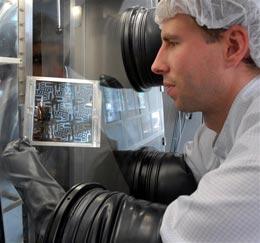Organic molecules organize themselves to form a bridge between electrodes.
 Computer circuits made from organic molecules could be used to build lightweight, flexible displays.ASSOCIATED PRESS
Computer circuits made from organic molecules could be used to build lightweight, flexible displays.ASSOCIATED PRESSA team of European physicists has developed an integrated circuit that can build itself. The work, appearing in this week's Nature1, is an important step towards its ultimate goal — a self-assembling computer.
Today's computer chips are made by etching patterns onto semiconducting wafers using a combination of light and photosensitive chemicals. But the technique is being pushed to the limit as ever more processing power is being packed onto chips, requiring engineers to etch details just a few tens of nanometres across. So scientists are hunting for alternative ways to assemble even tinier chips.
“We dump it in a beaker with a solution of the molecules, we take it out, we wash it, and it works.”
Dago de Leeuw
Philips Research Laboratories, the Netherlands
Letting them build themselves is, in many ways, the most obvious solution, says Dago de Leeuw, a researcher at Philips Research Laboratories in Eindhoven, the Netherlands. "The nicest example is DNA," he says. Our genetic code provides a set of instructions that can be used to marshal molecules into an entire person, and researchers would like to come up with a similar set of compounds able to organize each other into circuits.
That's no small task. To make a circuit that is truly self-assembling, physicists would need to get insulators, conducting electrodes and semiconductor transistors to all link to each other automatically — something that is still a long way away, says de Leeuw.
Chip 'n dip
But his team has made an important step. They took a long organic molecule with mobile electrons, called quinquethiophene, that behaves like a semiconductor and attached it to a long carbon chain with a silicon group at the end, which acts an an anchor.
“Self-assembly and nanotechnology is certainly cool, but the one thing missing is higher performance.”
Hagen Klauk
Max Planck Institute for Solid State Research, Germany
The researchers then dunked a circuit board with preprinted electrodes into a solution of their new molecules. The molecules hooked on to an insulating layer between the electrodes, forming bridges from one electrode to the next. It took billions to make the connection, but they were tightly packed enough that a current could flow across them. "The different molecules are like little bricks," says Edsger Smits, another researcher at Philips. "Frankly it worked much better than we expected."
The team used the technique to construct a simple circuit that generates a code based on an input voltage. Although the system depends on the preprinted electrodes to act as a template, the circuit is truly self-assembling, says de Leeuw: "We dump it in a beaker with a solution of the molecules, we take it out, we wash it, and it works."
The new technique is impressive but still needs improvement, says Hagen Klauk, an electrical engineer at the Max Planck Institute for Solid State Research in Stuttgart, Germany. "Self-assembly and nanotechnology is certainly cool, but the one thing missing is higher performance," he says. The mobility of electrons through the circuit, he explains, means that the transistors would make for a very slow computer.
Klauk hopes that improving the characteristics of the molecules and tweaking the technique will eventually lead to self-assembling circuits that out-perform existing technologies, which use thick films of organic molecules.
For his part, de Leeuw says the next step will be figuring out a way to develop self-assembling electrodes. In the meantime, however, he says the group's circuits may already have a use. Because the bridge of molecules is very thin, it is extraordinarily sensitive to passing particles. The team believes that it could be used to develop sensors for different kinds of airborne material, such as pathogens or dangerous chemicals.



No comments:
Post a Comment